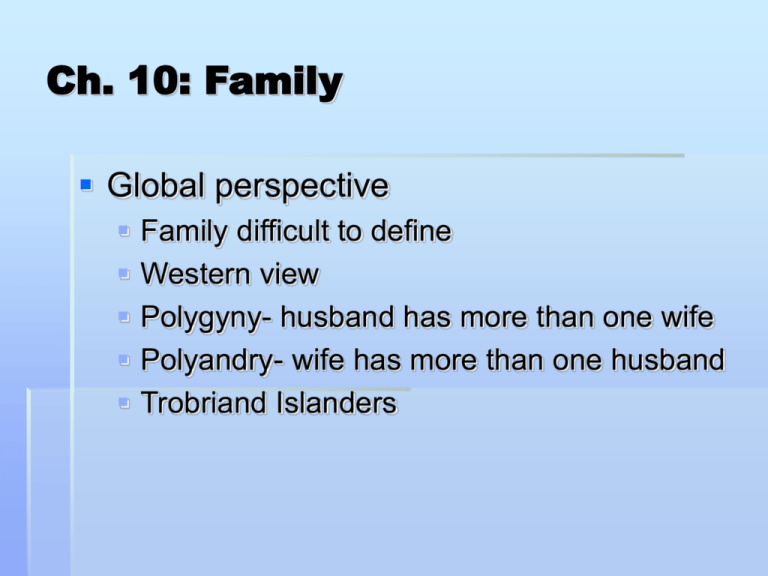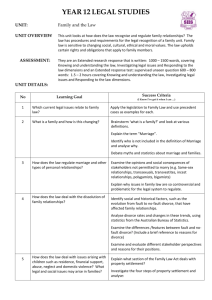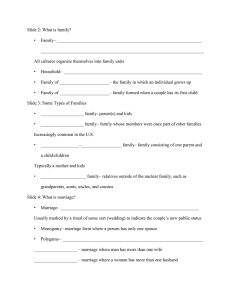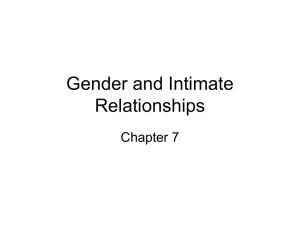
Ch. 10: Family
Global perspective
Family difficult to define
Western view
Polygyny- husband has more than one wife
Polyandry- wife has more than one husband
Trobriand Islanders
Family= 2 or more people who consider
themselves related by blood, marriage, or
adoption
Household= people who occupy the same
housing unit or living quarters
Nuclear family
Extended family
Family of orientation
Family of procreation
Marriage= a group’s approved mating
arrangements, marked by a ritual
Mate selection- norms of who marries
whom
Endogamy
Exogamy
Incest taboo
Descent- how related to relatives
System of descent
Bilateral system
Patrilineal system
Matrilineal system
Inheritance- rights of inheritance follow
lines of descent
Authority
Patriarchy- authority vested in males
U.S. patterns becoming more egalitarian
Naming patterns reflect patriarchy
Functionalism
Family is universal b/c it fulfills basic
needs
Economic production
Socialization of children
Care of the sick and aged
Recreation
Sexual control
Reproduction
Functions of the incest taboo
Avoid role confusion
Exogamy
Extends social networks of bride and groom
Dysfunctions
Isolation of nuclear family
Emotional overload
Conflict theory
Gender and power
Power struggle over housework
Arlie Hochschild- “the second shift”
Affects marital relationship and wife’s selfconcept
Men engage in strategies of resistance
Waiting it out
Playing dumb
Needs reduction
Substitute offerings
Symbolic interactionism
Gender and meanings of marriage
Closer husband and wife’s earnings,
more likely share housework
Husband earns less than wife, does least
amt. of housework
The family life cycle
Love and courtship in global perspective
Romantic love- 88% of societies
Role of love differs from one society to
another
Sexual attraction and labels
Love and arranged marriage in India
Marriage
Love is socially channeled
Homogamy- tendency of people w/ similar
characteristics to marry one another
Propinquity (spatial nearness)
94% of Americans marry someone from
same racial background
Childbirth
Education and income relationship
Marital satisfaction
Social class affects how couples adjust to
arrival of children
Working class vs. middle class
Child rearing
3 of 5 U.S. mothers work for wages
Married vs. single mothers similar child
care arrangements
Day care
Nannies
Social class- parents socialize their
children into the norms of their work
worlds
Birth order- tendencies
First vs. second or later born
Family in later life
The Empty Nest
Married couple’s domestic situation after
the last child has left the home
Difficult time of adjustment for women?
Rubin found that women’s satisfaction
generally increases when last child
leaves the home
The not-so-empty nest
Prolonged education
Household costs
42% of all U.S. 24-29 year olds live w/
their parents (boomerang children)
Widowhood
Women more likely than men
Deal w/ “who am I” again
Diversity in U.S. families
Social class is primary distinction
African American families
Upper vs. middle class
Poverty- men unemployed, have few
skills, women likely single mothers
45% of families headed by women
Fictive kin- stretching of kinship
Marriage squeeze- imbalance in sex ratio
Latino families
Social class and country of origin
significant
Cubans more likely headed by married
couple than Puerto Rican families
Culture- language, religion, and family
orientation
Machismo- emphasis on male strength
and dominance
Asian American families
Structure almost identical to white families
80% married couples, 13% female-headed
20 countries and cultures
Nuclear family w/ Confucian values
More permissive than Anglos in child
rearing
Native American families
Conflict- traditional values or assimilate
Permissive parenting
Elders play active role in family life
One-parent families
1970- 85% lived w/ both parents
2000- 69% lived w/ both parents
High divorce rate and increase in births to
unmarried women
Strain and poverty- most one parent
families headed by women
Kids more likely drop out of school, get
arrested, have emotional problems
Cycle of poverty
Families w/out children
About 20% of married women do not give
birth
Education
Race-ethnicity
Why remain childless by choice?
Not by choice- adoption, surrogate
mothers, high tech reproduction
Blended families
Members were once part of other families
Gay and lesbian families
1989- Denmark first to legalize same sex
marriage
2000- Vermont first legalized “gay unions”
Uneven distribution in U.S.
1/5th previously married to heterosexuals
Have children?
22% lesbian couples, 5% gay couples
Trends in U.S. families
Postponing marriage
Cohabitation
Adults living together in a sexual relationship
w/out being married
Change in views on sexual morality
High divorce rate= marriage is fragile
8 X more common today than 30 yrs ago
Essential difference?
Substitute for, step towards, trial, coresidential
dating
Unmarried mothers
Industrialized nations experienced sharp
increases in births to single women
Customs/values play large role
Grandparents raising grandkids
Skipped generation families
Parents are ill, homeless, incarcerated,
addicted to drugs
Sandwich generation and elder care
Responsible for own kids and aging
parents
Divorce
Problems in measurement
½ as many divorces are given each year as
marriages performed
When look at entire pool, divorce rate is 2%
Varies by where you live and race-ethnicity
Symbolic interactionism and the misuse of
statistics
Self-fulfilling prophecy
Children of divorce
More hostility, anxiety, don’t do as well in
school (accurate study?)
Conflict ridden intact families vs. kids of
divorce
Live w/ same sex parent= better
adjustment
As adults, less likely marry, more likely
divorce
The Absent Father/ Serial Fatherhood
Divorced father maintains high contact 1st
year or two after divorce-> meets new wife
Only 1/6 of kids who live apart from dad
see him every week
Most divorced fathers stop seeing their
kids altogether
The Ex-Spouses
Spouse who initiates divorce gets over it
sooner
Cost of living increases
Remarriage
Most who divorce remarry, likely remarry
other divorced people
Men more likely than women to remarry
Bring kids into new marriage, more likely
to divorce again
Two sides of family life
Battering (spouse abuse)
Husbands and wives equally likely attack
one another
Wives more often seek medical attention
Why stay in abusive relationship?
Child abuse
Each year about 3 million U.S. kids are
reported as victims of abuse/neglect
Marital rape (intimacy rape)
14% of married women report that their
husbands have raped them
Most commonly occur during a
separation or break up of a marriage
3 types- nonbattering rape, battering
rape, perverted rape
Incest
Sexual relations between certain
relatives
More common when socially isolated
Most common offenders?
Successful marriages
2/3 married Americans report they are
“very happy” w/ their marriages
Long term marriages- 15+ years
351 couples interviewed
300 happy, 51 unhappy
Why stay together?
What makes a happy marriage?
Spend time together, express appreciation,
committed to promoting one another’s
welfare, religious, deal w/ crisis in positive
manner








